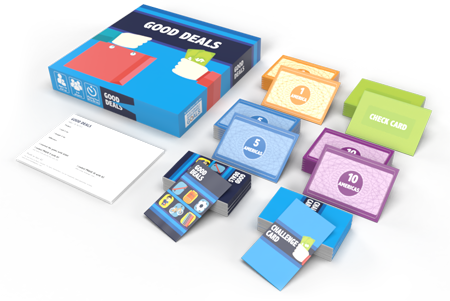
OBJECT
To sell well the products you bought and be the player with the most money at the end of the game.
COMPONENTS
• 24 product cards (numbered 1 to 24)
• 108 bill cards, 60 of A$1; 36 of A$5; and 12 of A$10
• 24 check cards from A$5 to A$120
• 12 challenge cards
• table of notes
PREPARATION
• Sort the cards by type (product, bill, check, and challenge) and shuffle each one of the decks;
• Set aside the check cards and challenge cards. They will only be used in the second and third phases of the game;
• Put product cards face-down, in a deck;
• Each player starts the game with sixty Americas (A$60), with the bills distributed as follows: • 10 bills of A$1; 6 bills of A$5; and 2 bills of A$10;
• Select a player to be the banker, who will be in charge of the distribution of money and the payments made during the game;
• If there are five players, remove four product cards and four check cards. The four product cards (1 to 4) and the four check cards with the lowest values (A$5, A$10, A$15 and A$20) must be removed. After removing the cards with the lowest values, the game follows the same strategy that had been thought out.
HOW TO PLAY
1st Phase – Buying the products
1) Place the product cards matching the number of players face up on a table. For example, if there are six players, place six product cards; if there are four players, place four cards. In the first round, the first player makes a bid, not for a specific product, but for everyone in the round by placing one or more bill cards on the table. The next player (turns go clockwise) must decide whether to bid higher or lower (the bid can never be equal to the existing bids). All players are required to make a first bid. The bids go on and the players can either raise the amount bid by the other players or skip their turn. When the players skip their turn, they do not participate in the round and so on until everyone is satisfied. The player who made the highest bid gets the most valuable product card, the player who made the second highest bid gets the second most valuable product card, and so on. The players write in the table of notes the product they bought and the purchase price.
2) A new set of product cards gets turned over. The players continue to buy following the same logic, until all products are purchased. Attention: occasionally, one player may spend all of his/her money while there are no more product cards left. In this case, when placing the product cards on the table, randomly remove the number of cards that matches the number of players without any money and place on the table only the number of product cards that matches the number of players with money (the product cards removed are no longer used in the game). Do that until all product cards have been distributed and purchased, or until all players are out of money..
2nd Phase – Selling the products
1) Place the number of check cardsmatching the number of players in the center of the table, with the value facing up. The players analyze the values and, following a strategy, choose one of their product cards to be sold by placing it on the table, face down (the selected product must not be shown to the other players).
2) All players turn their product cards at the same time. The player with the highest value product gets the highest value check card. The player with the second highest value product gets the second highest value check card, and so on. Each player writes in the table of notes the value of the check card below the product sold.
3rd Phase – Optional challenge
The third phase of the game is optional. Each player draws a challenge card, with earnings and expenses inherent to an enterprise, including tax education.
END OF THE GAME
The game ends when everyone has sold their products. After doing the calculations included in the table of notes, the player with the most money wins. In order to check this, everyone should add the value of their check cards and bill cards, and follow the instructions on the challenge cards, if used. If necessary, they may use calculators.
